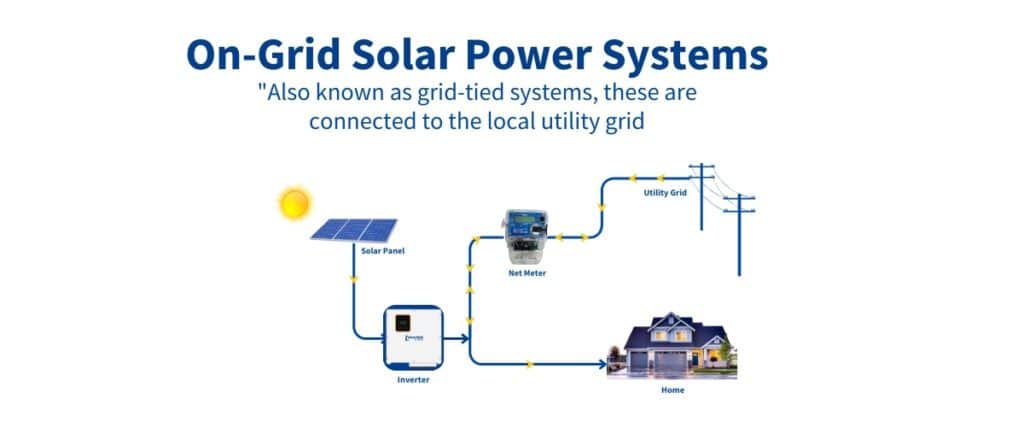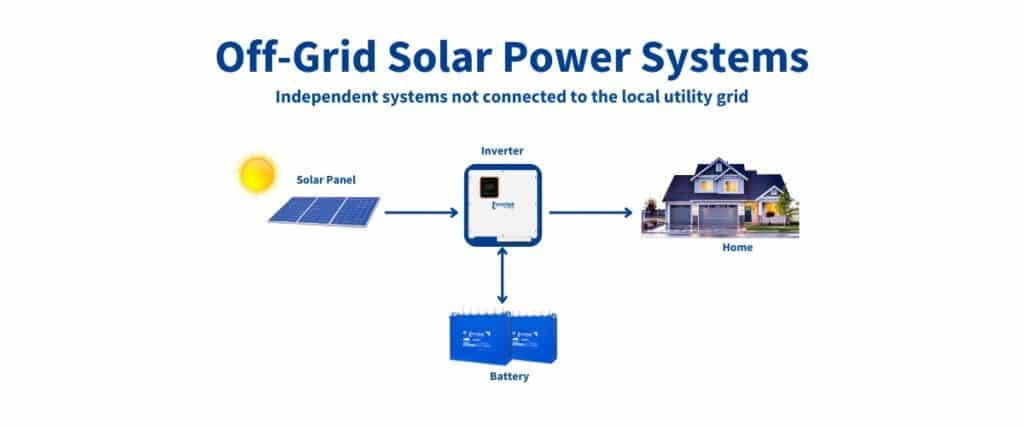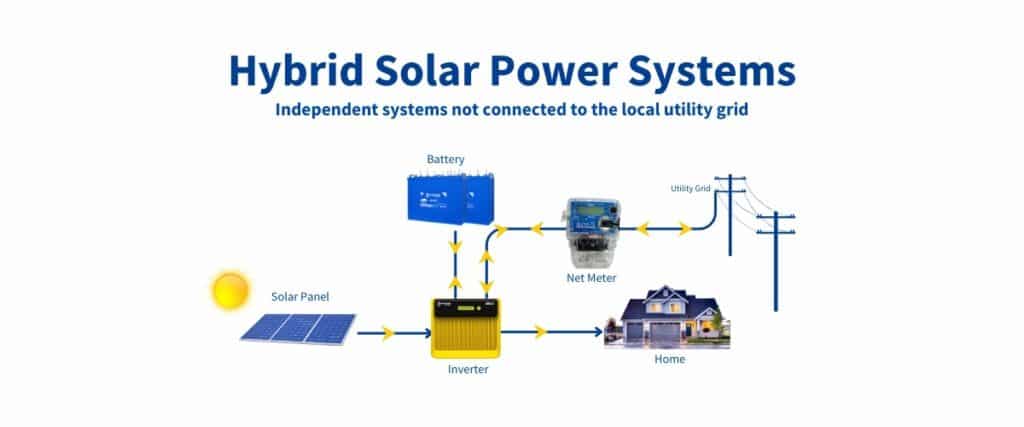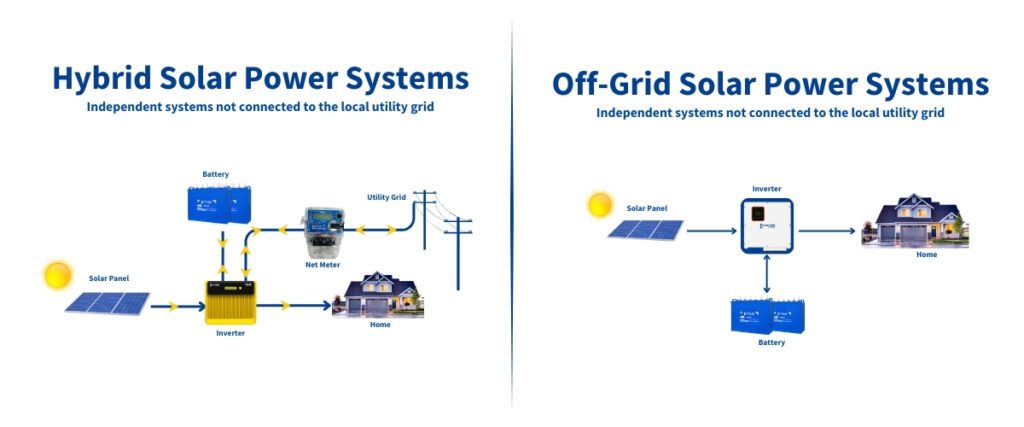The increasing awareness of the value of renewable energy sources has led many homeowners to consider solar energy as a means of powering their homes. Solar panels are a great way to overcome your carbon footprint and save money on electricity bills.
We can classify solar systems into three classes: on-grid, off-grid, and hybrid. This article will explain these types in detail.
On-Grid solar system
A grid-tied solar system generates electricity through solar panels and channels any surplus power back into the grid. It is connected to the main electrical power grid. When the solar panels fail to produce sufficient power, electricity will be sourced from the grid.

Off-Grid solar system
An off-grid solar system runs separately from the main power grid. It is comprised of solar panels, a charge controller, energy-storage batteries, and occasionally a backup generator for unexpected situations. Off-grid systems are common in isolated locations where it is expensive or difficult to connect to the grid.

Hybrid solar system
A hybrid solar system integrates solar energy with an alternate power source, usually a generator or the primary power grid, coupled with battery storage. This approach offers the advantages of eco-friendly solar power and the dependability of a backup power source when solar output is inadequate.

Hybrid solar power inverter
To work with hybrid solar systems, a hybrid solar power is designed which is also known as a hybrid inverter. Here are some properties of the hybrid solar power inverter:
- Inverter Mode: They convert the direct current (DC) electricity created by solar panels into alternating (AC) electricity for continuous use in the home or business.
- Charger/Discharger Mode: They manage the charging and discharging of battery storage systems, allow extra solar energy to be stored in batteries for later use, and draw power from batteries when solar generation is deficient.
- Battery Management: They optimize battery charging from solar panels, grid, or generator sources and rank battery usage based on user-defined settings or energy management algorithmic programs.
Disadvantages of Hybrid Solar System
While hybrid solar systems offer various advantages, they also have a few potential disadvantages:
- Complexity and Cost: Hybrid systems are more complex and expensive to install than purely on-grid or off-grid systems. This is because they require extra components such as batteries and specialized inverters to manage grid connection and battery storage.
- Maintenance: The component of battery storage introduces another constituent that requires maintenance. Batteries devalue over time and may need to be replaced, adding to the overall maintenance costs of the system.
- Performance Losses: It might experience performance losses because of the need to convert electricity multiple times between direct and alternative current, AC and DC again. Each changeover step incurs some energy loss, overcoming the general efficiency of the system.
- Limited Battery Life: The batteries lifespan used in it is finite, mostly ranging from 5 to 15 years depending on the battery type and usage patterns. This means that eventually, the batteries will need to be arranged, adding to the long-term costs of the system.
- Dependence on Grid Stability: While hybrid systems offer little energy level independence during grid outages, they still trust the grid for backup power. If the grid is unstable or experiences extended outages, the hybrid affectivity system might be compromised as a backup power source.
How does a hybrid solar system work?
It works by integration solar panels, battery storage, and sometimes a backup power source to supply reliable and efficient electricity supply. Here’s a stepwise breakdown of how it operates:
1. Solar Energy Generation:
Solar panels, mostly affixed on the roof or in an open area with full sunlight exposure, acquire sunlight and convert it into electricity through the photovoltaic effect. This electricity generated by the solar panels is in the form of DC electricity.
2. Inverter Conversion:
Solar panels create direct current and send it to an inverter to generate alternating current (AC), which is the regular form of electricity used in businesses and homes.
3.Immediate Power Consumption:
The AC electricity produced by the inverter is utilized to power electrical appliances and devices in the house or business in real-time. If the electricity supply exceeds the quantity generated by the solar panels, extra power might be drawn from the battery storage system.
4. Battery Storage:
The battery storage system typically consists of a charge accountant, who negotiates the charging and discharging of the batteries, guaranteeing their longevity and efficient operation.
5. Monitoring and Control:
It often consists of monitoring and control systems that permit users to monitor energy production, battery storage levels, and the system’s overall performance. Users can access this information through a control panel or smartphone application, optimizing energy usage and maximizing the benefits of the hybrid solar system.
Steps to Transform an On-Grid Solar System into a Hybrid System
Converting an existing on-grid solar system to a hybrid system includes adding battery storage and potentially integrating a backup power source. Here’s a general guide on how to convert your on-grid solar system to a hybrid system:
Step 1- Assess Your Current System:
Assess your existing on-grid solar system to understand its capacity, constituent, and energy production patterns. This appraisal will help determine the proper size and type of battery storage system for the hybrid setup.
Step 2- Select Battery Storage System:
Select a battery storage system congruous with your existing solar panels and inverter. Consider factors like battery capacity, voltage, cycle life, and compatibility with your inverter and charge controller.
Step 3- Install Battery Storage System:
Install the battery storage system according to the manufacturer’s instructions and local building codes. This may include mounting the batteries, connecting them to the solar inverter and charge controller, and configuring the system for optimal presentation.
Step 4- Update Inverter and Charge Controller:
If essential, update or upgrade your solar inverter and charge accountant to ensure the characteristics of the battery storage system. Some inverters may necessitate firmware updates or extra hardware to support hybrid operation.
Step 5- Configure System Settings:
Assemble the settings of your solar inverter, charge controller, and battery management system to optimize execution and maximize the utilization of renewable energy resources. This may consist of setting charge/discharge parameters, adjusting voltage and frequency settings, and configuring backup power source preferences.
Step 6- Monitor and Maintenance:
Monitor the presentation of your hybrid solar system regularly and perform routine maintenance tasks, such as cleaning solar panels, inspecting battery connections, and checking for signs of wear or damage.
Hybrid solar inverter vs. Off-grid inverter
Hybrid solar inverters and off-grid inverters serve various purposes in solar systems:
Hybrid Solar Inverter:
Hybrid solar inverter is designed to work with both on-grid and off-grid solar systems. It integrates features for grid-tied operation, battery storage, and a backup power source. Hybrid systems usually have charge controllers and monitoring systems built in to manage energy efficiently and ensure smooth operation.
Off-Grid Inverter:
Off-grid inverters are designed for use in standalone, off-grid solar systems that are not connected to the chief electricity grid. They do not usually have grid-tied capabilities or support for backup power sources. They are intended for standalone operation in remote locations where grid connection is not available or practical.

Conclusion
In conclusion, the choice between on-grid and off-grid solar systems at last depends on your location, budget, and energy needs. Carefully classifying your specific situation will help you decide which system is best for your home or business.
Additionally, hybrid systems can provide a cooperation solution for those seeking the advantages of both worlds. Thoughtless of your choice, both on-grid and off-grid solar systems impart a greener and more sustainable future. A hybrid solar system might be the solution if you can’t decide among on-grid and off-grid systems.


